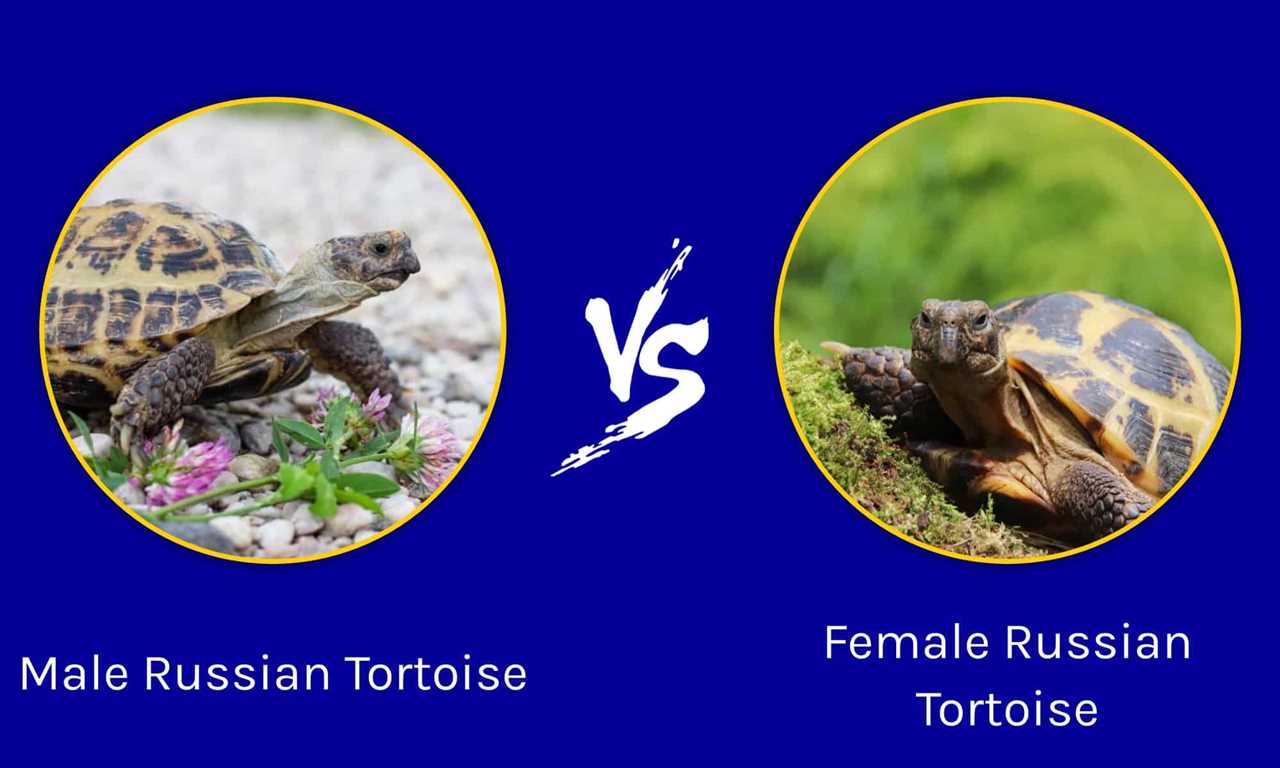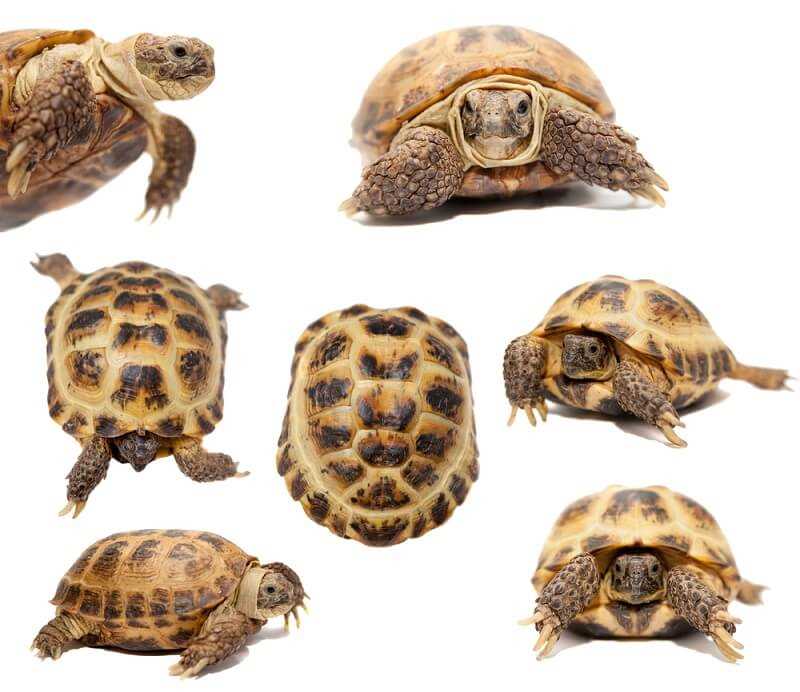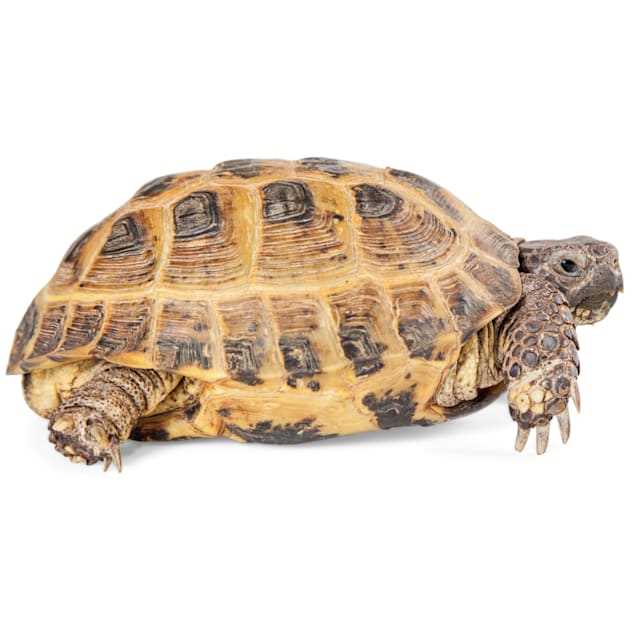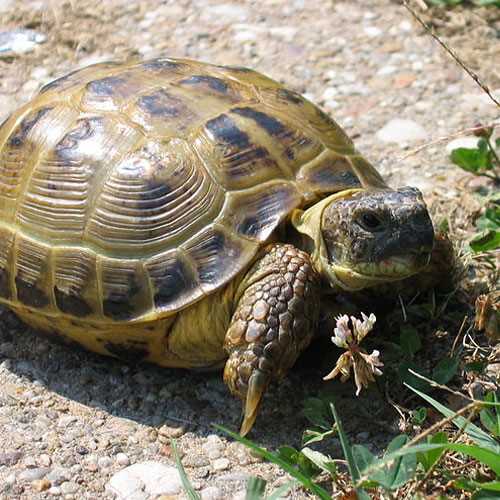
Female Russian tortoises are fascinating creatures with unique characteristics and specific care requirements. These small to medium-sized tortoises are native to the arid regions of Central Asia, where they have adapted to survive in harsh desert conditions. Known for their hardy nature and gentle disposition, Russian tortoises make popular pets for reptile enthusiasts of all ages.
One of the striking features of female Russian tortoises is their size. They typically grow to be around 6-8 inches long, making them more compact than their male counterparts. Their shells are usually round and dome-shaped, providing them with excellent protection against predators. Female Russian tortoises also have shorter and stubbier tails compared to males, making it easier to identify their gender.
Feeding is another important aspect of caring for female Russian tortoises. They are herbivores, preferring a diet high in fibrous plants, such as grasses, leafy greens, and vegetables. It’s essential to provide a variety of fresh foods to ensure they receive all the necessary nutrients. Additionally, calcium and vitamin supplements should be given to prevent common deficiencies and promote healthy shell growth.
Key Traits of Female Russian Tortoises
Another important trait of female Russian Tortoises is their diet. These tortoises are mainly herbivorous, consuming a variety of grasses, vegetables, and fruits. It is crucial to provide them with a balanced diet that includes calcium-rich foods to support their shell health.
Female Russian Tortoises also have unique reproductive traits. They are oviparous, which means they lay eggs rather than giving birth to live young. Females usually dig shallow nests in the ground to lay their eggs, and the eggs hatch after an incubation period of about 90-120 days.
In terms of behavior, female Russian Tortoises are generally peaceful creatures. They are not as territorial as males and can coexist with other tortoises within a suitable habitat. However, it is essential to provide them with enough space and hiding spots to reduce potential stress.
Physical Characteristics and Appearance

The head and limbs of the Russian tortoise are relatively small compared to its body size. The head is triangular in shape and has a slightly hooked upper jaw. The eyes are small and have a dark coloration. These tortoises have four sturdy legs with strong claws that are adapted for digging and moving through the soil.
- The skin of a Russian tortoise is rough and has a scaly appearance.
- They have a beak-like mouth with a horny covering.
- The front legs of female Russian tortoises are usually shorter and broader compared to the males, which helps them in digging their nests.
Diet and Nutrition for Female Russian Tortoises
1. Variety of Foods
2. Grasses and Hay
Grasses and hay should make up a significant portion of a female Russian tortoise’s diet. These tortoises consume high-fiber grasses in the wild, and incorporating them into their diet in captivity is essential for their digestive health.
3. Leafy Greens
Leafy greens, such as dandelion greens, collard greens, kale, and mustard greens, should be staple components of a female Russian tortoise’s diet. These greens are rich in essential vitamins and minerals.
4. Avoid Toxic Plants
Ensure that the foods provided to the tortoise are safe and free from toxic plants. Some commonly available plants can be harmful to tortoises, so it is essential to research and identify safe food options.
5. Limited Fruits
While fruits can be incorporated into a female Russian tortoise’s diet, they should be provided in moderation due to their high sugar content. Fruits like strawberries, melons, and apples can be given as occasional treats.
6. Calcium and Vitamin D3
Female Russian tortoises require adequate calcium and vitamin D3 to maintain proper bone health. Dusting the food with a calcium supplement or providing cuttlebone for the tortoise to chew on can help meet their calcium requirements.
7. Water
Remember to consult with a reptile veterinarian or herpetologist for specific dietary recommendations and to ensure that the tortoise’s nutritional needs are met. Monitoring the tortoise’s weight and overall health is also crucial for determining if any adjustments need to be made to its diet.
Habitat and Environmental Requirements for Female Russian Tortoises
Female Russian tortoises have specific habitat and environmental requirements that need to be met in order for them to thrive and stay healthy. Providing a suitable habitat is essential for their overall well-being. Here are some key factors to consider when setting up an enclosure for a female Russian tortoise:
1. Enclosure Size
The size of the enclosure is crucial as it provides the tortoise with ample space to move around and exercise. Ideally, the enclosure should be at least four times the size of the tortoise’s length and should have a yard area as well.
2. Substrate
Choosing the right substrate is important for a female Russian tortoise’s habitat. A suitable substrate should be a mixture of topsoil, sand, and coconut coir, which mimics their natural habitat. It should be deep enough for tortoises to dig and burrow to regulate their body temperature and forage for food.
3. Temperature and Humidity
Monitoring and maintaining the temperature and humidity levels in the enclosure is crucial for the health of a female Russian tortoise. The enclosure should have a temperature gradient, with one side warmer (around 90-95°F) and the other slightly cooler (around 75-80°F). A basking spot should also be provided, with a temperature of around 100-105°F. The humidity level should ideally be around 50-60%.
4. Lighting
Proper lighting is essential for the well-being of female Russian tortoises. They require access to both UVB and UVA lighting. UVB light helps in the synthesis of vitamin D3, which helps with calcium absorption, while UVA light helps promote natural behaviors and helps them see better. It is recommended to provide a full-spectrum UVB light for 10-12 hours a day.
5. Hiding spots and Enrichment
Providing hiding spots and enrichment in the enclosure is important for the mental stimulation of female Russian tortoises. Hiding spots can be created using rocks, logs, or plants. Adding different textures, like straw or leaves, can stimulate their natural foraging behaviors. Additionally, providing toys or objects to explore and interact with can help keep them engaged and prevent boredom.
6. Food and Water

By carefully considering and meeting these habitat and environmental requirements, female Russian tortoises can live a healthy and fulfilling life. Regular monitoring and maintenance of the enclosure will ensure that these beautiful creatures thrive in a suitable and enriching environment.
Reproduction and Lifecycle of Female Russian Tortoises
After mating, the female will lay eggs in a nest she digs in the ground. The number of eggs laid can vary, usually ranging from 2 to 8 eggs per clutch. The incubation period usually lasts around 70 to 90 days, but it can vary depending on factors such as temperature and humidity.
Female Russian tortoises can reproduce multiple times throughout their lives, though it is essential to allow them sufficient time to recover between clutches. Breeding too frequently can put excessive strain on their bodies and may result in health issues or reduced lifespan.
Social Behavior and Interaction of Female Russian Tortoises
Female Russian Tortoises are generally sociable creatures and exhibit certain behaviors and interactions that are important to understand for their overall well-being.
Territorial Behavior
Mating Behavior
Social Hierarchy
Note: It is not recommended to house female Russian Tortoises with male tortoises unless you are specifically planning to breed them. Male tortoises can be more dominant and may cause stress or injuries to the females.
Interaction with Humans
Common Health Issues in Female Russian Tortoises
1. Respiratory Infections: Female Russian tortoises are susceptible to respiratory infections, which can be caused by poor husbandry practices or exposure to cold, damp conditions. Symptoms may include wheezing, lethargy, and lack of appetite. A visit to a veterinarian familiar with reptile care is necessary for diagnosis and treatment.
2. Shell Rot: Shell rot is a common health issue in female Russian tortoises that can occur due to inadequate humidity levels and poor hygiene. It is characterized by softening or discoloration of the shell. Regularly cleaning and drying the shell and providing a proper habitat can help prevent shell rot.
3. Parasitic Infections: Russian tortoises can be affected by internal and external parasites such as worms, ticks, and mites. These parasites can cause weight loss, weakness, and poor overall health. Regular fecal tests and preventative treatments can help keep parasites under control.
4. Egg Retention: Female Russian tortoises are prone to egg retention, which occurs when they are unable to lay their eggs. This can lead to infections and other complications. Providing a suitable nesting area and monitoring the tortoise’s behavior can help prevent egg retention.
6. Injury: Female Russian tortoises can sustain injuries, such as cuts or shell cracks, from rough handling, falls, or encounters with sharp objects. These injuries can become infected if not treated promptly. It is essential to handle tortoises gently and provide a safe environment to prevent injuries.
Regular veterinary check-ups, proper nutrition, and a suitable habitat can greatly reduce the risk of these health issues in female Russian tortoises. Monitoring their behavior and seeking professional help when needed are key to maintaining their well-being and ensuring a long, healthy life.
The Importance of Providing Proper UVB Lighting for Female Russian Tortoises
In the wild, female Russian tortoises have access to natural sunlight, which provides them with the necessary UVB rays. However, when kept in captivity, it is essential to mimic this natural light source by using UVB bulbs specifically designed for reptiles. These bulbs emit UVB rays that are necessary for the production of vitamin D3 in the tortoises’ skin.
Proper UVB lighting is vital for female Russian tortoises, as it helps prevent various health issues, such as metabolic bone disease. Metabolic bone disease occurs when tortoises are not provided with adequate UVB lighting and calcium-rich diets. Without UVB rays, their bodies cannot effectively absorb the calcium they need to maintain healthy bones and shells.
While providing the appropriate UVB lighting is crucial, it is equally important to regulate the exposure time. Female Russian tortoises should have access to UVB lighting for approximately 10-12 hours a day. This mimics the natural sunlight cycle and ensures they receive the necessary UVB rays without excessive exposure.
Temperature and Humidity Needs for Female Russian Tortoises
Proper temperature and humidity are essential for the health and well-being of female Russian tortoises. These reptiles require a warm and dry environment to thrive.
Humidity levels for female Russian tortoises should be kept relatively low, around 30-40%. Excess moisture can lead to respiratory issues and shell rot. To maintain proper humidity levels, it is crucial to provide good ventilation in the enclosure and avoid excessive misting or water dishes that may increase humidity levels.
A digital thermometer and hygrometer should be used to monitor the temperature and humidity inside the enclosure regularly. This will ensure that the conditions are appropriate for the tortoise’s needs.
It is also essential to provide a UVB light source for female Russian tortoises. UVB light is necessary for the synthesis of vitamin D3, which allows them to absorb and metabolize calcium properly. This is crucial for healthy shell growth and overall health. The UVB light should be on for 10-12 hours a day and should be replaced every six months to ensure its effectiveness.
By providing the correct temperature and humidity levels, along with a suitable basking spot and UVB lighting, you will ensure that your female Russian tortoise remains healthy and happy for years to come.
Handling and Care Tips for Female Russian Tortoises
Female Russian tortoises require careful handling and proper care to ensure their health and well-being. Here are some tips to help you provide the best care for your female Russian tortoise:
1. Approach with Caution
2. Support the Shell
When picking up your female Russian tortoise, it is essential to support her shell properly. Place one hand underneath her belly, supporting her weight, and use the other hand to support her shell. Avoid picking her up by the limbs, as this can cause injury or stress.
3. Keep it Low
When handling your female Russian tortoise, it is recommended to keep her close to the ground. This minimizes the risk of drops or falls, which can cause severe injuries. Make sure to provide a safe and secure area for handling to prevent any accidents.
4. Limit Handling Time
5. Wash Your Hands
Before and after handling your female Russian tortoise, make sure to wash your hands thoroughly. This helps prevent the transmission of harmful bacteria and other contaminants that may affect her health or yours.
6. Provide a Tortoise-Friendly Environment
Creating a suitable enclosure for your female Russian tortoise is crucial for her overall well-being. Ensure that her habitat provides ample space to explore, bask, and hide. Include a variety of vegetation, hiding spots, and a temperature gradient to create a comfortable and enriching environment.
7. Pay Attention to Her Behavior

Regularly observe your female Russian tortoise’s behavior to ensure she is healthy and happy. Look for signs of stress, such as excessive hiding, loss of appetite, or unusual behaviors. If you notice any concerns, consult with a veterinarian specializing in reptile care.
By following these handling and care tips, you can provide the best possible care for your female Russian tortoise, promoting her health, happiness, and longevity.
Creating a Suitable Enclosure for Female Russian Tortoises
1. Size
The size of the enclosure is crucial for the well-being of your female Russian tortoise. It should be spacious enough to allow her to move around comfortably. As a general rule of thumb, the enclosure should be at least four times the length of the tortoise and twice the width.
2. Substrate
Choosing the right substrate is crucial for the health of your tortoise. The substrate should be a mixture of soil, sand, and coconut coir to provide a naturalistic environment. Avoid using sand alone, as it can cause impaction if ingested.
3. Hideouts and Basking Areas
Your female Russian tortoise should have access to hideouts and basking areas within her enclosure. This will allow her to retreat and feel secure when needed. Provide rocks, logs, and plants to create hiding spots, and include a basking area with a heat lamp for thermoregulation.
4. Lighting and Heating
Proper lighting and heating are essential for the health of your female Russian tortoise. Provide a UVB lamp to mimic natural sunlight, which is important for calcium absorption and overall health. Additionally, maintain a basking spot temperature of around 90-95°F (32-35°C) and a cooler side of the enclosure around 75°F (24°C).
5. Water Source
Your female Russian tortoise should have access to clean, fresh water at all times. Provide a shallow dish or bowl that she can easily access and soak in if desired. Regularly clean and refill the water to ensure its cleanliness.
6. Environmental Enrichment
Enrich your female Russian tortoise’s enclosure with various elements to stimulate her natural behaviors. This can include plants for grazing and hiding, rocks and branches for climbing, and even toys or puzzles for mental stimulation.
7. Maintenance and Cleaning
Regular maintenance and cleaning of the enclosure are necessary to ensure the health and well-being of your female Russian tortoise. Remove any uneaten food, feces, and soiled substrate on a daily basis. Deep clean the enclosure at least once a month, replacing the substrate and disinfecting any equipment or decorations.
By following these guidelines, you can create a suitable enclosure for your female Russian tortoise that promotes her health and happiness. Remember to regularly monitor her behavior and make any necessary adjustments to ensure her well-being.
Resources for Further Information
| Websites |
|
| Books |
|
| Online Forums |
|
| Local Herpetological Societies |
|

I’m Lena Adams—a product of an unconventional upbringing in the African wilderness. My father, a daring explorer of African wildlife, sparked my fascination with reptiles, a passion that intertwined with the tragic loss of my mother during an expedition, leaving an indelible mark on my life. Driven to understand the creatures that captivated my parents, I embarked on my journey, sharing insights about reptiles, frogs, and lizards on my website. Through my explorations and conservation efforts, I honour my family’s legacy while seeking connections—to the creatures, nature, and the mother whose presence I yearn to understand.
